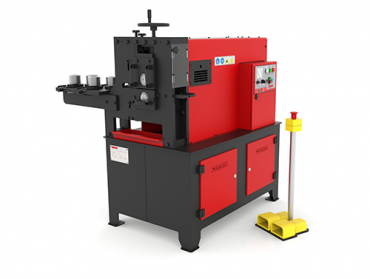Iron embossing machines
Frequently Asked Questions about NARGESA Cold Engraving Machines
What is the difference between cold and hot engraving?
The main difference between cold and hot engraving lies in the process and the associated costs. Cold engraving machines allow for the creation of designs and reliefs in a much simpler and more economical way, as they do not require the use of heat. However, this type of engraving tends to be shallower due to the absence of high temperatures that facilitate greater penetration into the material.
On the other hand, hot engraving allows for deeper and more pronounced reliefs, but it involves a more expensive process since it requires heating the material using a propane oven or other thermal systems. This heating increases the complexity and energy consumption of the operation.
An example of a cold engraving machine is the Noa 60 from Nargesa, which allows work on flat bars, tubes, and solid metal without the need to apply heat. This machine offers an efficient and cost-effective solution for creating decorative or functional engravings without compromising the integrity of the material or requiring additional heating equipment.
What materials can be engraved with these machines?
Engraving machines, especially cold engraving machines, are primarily designed to work with metallic materials, particularly ferrous metals. Among the most common are:
- Iron
- Carbon steel
- Aluminum
- Brass
- Copper
- Gold
Among these, the most commonly used materials for decorative purposes are:
- Carbon steel (with resistance below 45 kg/mm²), which is the most commonly used due to its strength and versatility.
- Brass, which is in high demand in Arab countries for its golden finish and aesthetic appeal.
- Aluminum, increasingly popular especially in coastal areas due to its corrosion resistance, light weight, and ease of processing. Its use has grown for health and durability reasons, as it does not oxidize over time like other metals. T
hese characteristics make cold engraving machines an excellent choice for working with a wide variety of metals in decorative or industrial projects without the need to apply heat.
Can personalized logos be engraved, or only fixed patterns?
Yes, it is possible to engrave personalized logos, letters, shapes, and various patterns using engraving machines from the Nargesa brand. These machines use a roller engraving system that allows customized designs to be applied to different types of metallic materials.
The only technical aspect to consider is that, since it is a roller, the design is limited by the roller’s diameter, which determines the total length of the engraving before it repeats. For example, a roller with a diameter of 100 mm has a development (design length) of approximately 314 mm. This means that every 314 mm, the engraved pattern will repeat along the bar, tube, or flat bar being used.
In most cases, this is not a limitation, as designs are generally repetitive in nature, especially in decorative or ornamental applications. Nevertheless, it is important to consider this factor when designing logos or unique elements to ensure they fit properly within the roller’s format.
Do the machines allow for quick changes of rollers or molds?
Yes, all Nargesa engraving machines are designed to allow quick roller changes, which facilitates greater operational efficiency. The replacement process is very simple and usually takes no more than 2 minutes.
In today’s production environment, where operator time is increasingly valuable, these kinds of solutions are key to improving productivity. The speed of roller changes allows for design adjustments or piece customization without interrupting the workflow, thus optimizing manufacturing times and reducing operating costs.
What level of precision does cold engraving offer on metal profiles?
Cold engraving on metal profiles using Nargesa machines offers maximum precision. The process is highly reliable, as the machine accurately reproduces the design engraved on the roller, ensuring each repetition is identical to the last.
Any variation in the final result does not stem from the design itself but from the depth of the marking, which can be adjusted according to the operator’s preferences. As far as the design is concerned, there are no deviations; it remains consistent throughout the process.
Additionally, these machines have proven to be highly durable and efficient. According to customers who use them for over 8 hours a day, the rollers begin to show signs of wear only after 7 or 8 years of continuous use, which equates to thousands of kilometers of engraved bars or tubes. This combination of precision, repeatability, and durability makes cold roller engraving a highly efficient and reliable solution for large-scale work.
What are the uses of this type of engraving in metalworking or locksmithing?
Cold roller engraving has multiple applications in the field of metalworking and locksmithing, both decorative and functional. Some of its main uses include:
- Decoration of grilles, railings, and gates, allowing for repetitive and precise application of ornamental patterns or logos, enhancing the aesthetic finish of metal elements.
- Customization of metal structures, enabling logos, letters, or personalized symbols to be engraved on profiles, tubes, or flat bars, which is highly valued in custom or designer projects.
- Manufacture of decorative metal furniture, such as tables, chairs, shelves, or metal doors with engraved details that add distinction and style.
- Production of serial parts, ideal for manufacturers who need to repeat a design continuously and uniformly in large quantities.
- Identification or marking of parts, useful for including brands, codes, or technical text without the need for labels or additional processes.
Thanks to its precision, low operating cost, and ease of use, this type of engraving has become a highly valued tool among locksmiths, metalworkers, and manufacturers of decorative structures.
Is it compatible with mass production?
Yes, this type of cold engraving is fully compatible with mass production. In fact, Nargesa’s roller engraving machines are designed to operate continuously, repeating the same pattern with high precision and uniformity over large quantities of material.
Thanks to the speed of roller changes, low maintenance, and the wear resistance of components, these machines can work for long shifts without losing engraving quality. This makes them ideal for production lines that require engraving thousands of meters of tubes, flat bars, or profiles with the same design or logo. Moreover, since no heat is required, the process is more energy efficient and safer, reducing operating costs and making it easier to integrate into industrial environments.
In summary, it is a solution perfectly suited to mass production, both in large volumes and medium-sized production batches.
What maintenance do engraving rollers require?
The engraving rollers used in cold engraving machines require minimal maintenance, making them a very practical and cost-effective long-term option.
These rollers are made from high-strength materials, designed to withstand long working hours without losing precision or engraving quality. According to users who operate the machines for more than 8 hours a day, the roller only begins to show signs of wear after 7 or 8 years of intensive use, equivalent to thousands of kilometers of engraved material.
To ensure durability, it is recommended to:
- Clean the roller regularly to avoid the accumulation of metal debris or dust.
- Lubricate moving parts according to the machine manufacturer’s instructions.
- Check the adjustment and pressure applied by the roller to avoid unnecessary wear.
- Properly store the roller when not in use, protecting it from impacts or humidity.
With these basic care measures, the roller can provide optimal performance for many years, maintaining engraving quality without the need for frequent replacements.
Can galvanized or treated surfaces be engraved?
Yes, it is possible to engrave galvanized flat bars, tubes, or profiles using the cold roller engraving system. However, it is not an efficient or recommended procedure in most cases. This is because the roller tends to drag or remove the galvanizing layer, leaving the base material exposed. As a result, the part must be re-galvanized after engraving, which significantly increases costs and processing time.
As for heat-treated or high-hardness materials (above 65 kg/mm²), they are also not suitable for cold roller engraving. Due to their hardness, the engraving does not achieve visible depth, and the roller suffers accelerated wear, considerably reducing its service life.
In such cases, especially where treated, hardened, or already galvanized surfaces need to be engraved, it is more appropriate to use technologies such as laser engraving, which allows non-contact marking with high precision and without affecting surface coatings.
Join to our Newsletter
Be part of our Nargesa Community and get all information of the branch, demo clips, campaigns in Machinery…















